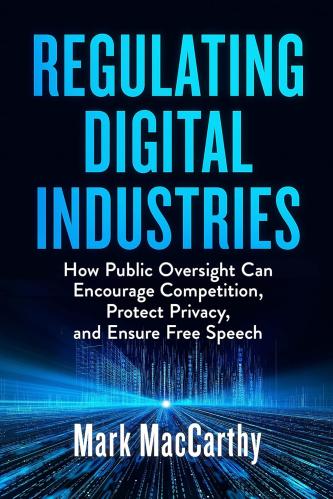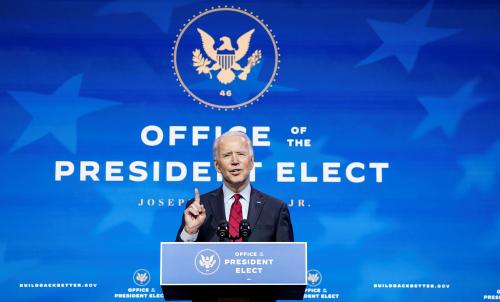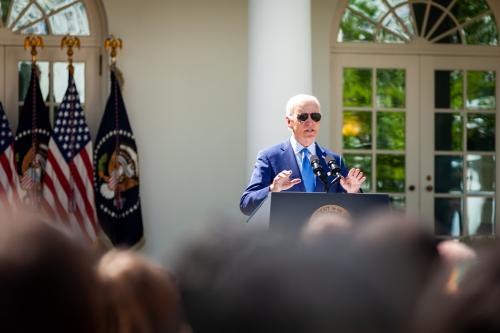A couple of weeks ago the Center for Equitable Growth released a set of thoughtful recommendations for promoting tech competition. Authored by an all-star cast of antitrust practitioners, scholars and activists, including Bill Baer, a Brookings Governance Studies Visiting Fellow, the report calls for new legislation to overrule judicial decisions that hamper vigorous antitrust enforcement and to increase funding for the antitrust agencies. It also recommends appointing strong antitrust heads of the agencies to lead proactive enforcement that would deter the development of market power. The Biden administration would do well to implement these measures to restore competition.
But Biden administration would also do well to ignore the report’s last recommendation, which is to create a White House Office of Competition. The new competition office would work with the Office of Information and Regulatory Affairs in the Office of Management and Budget, a small office charged with reviewing agency regulations for conformity with a cost-benefit standard. The mission of the new White House competition office would be to prevent anticompetitive capture of regulatory agencies and to block rules that would entrench incumbents at the expense of new competitors.
The history of regulation at OIRA
To understand the risks of this proposed new White House competition office, it is important to recognize that for decades OIRA has been the site of abuses of the regulatory process. In a recent commentary, influential Ohio State University legal scholar Peter Shane notes that the administrative mandate for centralized approval of cost-benefit analyses set up by the Reagan administration and elaborated during the Clinton presidency have slowed “substantive rulemaking” since the 1980s and “can prolong rulemakings by months.”
These reviews have endured through each successive presidency. After the Clinton years, the second Bush administration centralized regulatory power through the review process to promote a deregulatory agenda. The Obama administration installed noted legal scholar Cass Sunstein as OIRA head who reinforced this centralizing tradition with its cost-benefit approach, and recommended it for independent agencies like the Federal Trade Commission and the Federal Communications Commission that technically fall outside the purview of administration executive orders.
The Trump administration used the centralized process to mandate that regulatory agencies repeal two regulations for each new one, to install officers in each regulatory agency to enforce its deregulatory agenda, and to manipulate cost-benefit analyses when they did not support the push to repeal regulations.
The perils of centralized regulatory review
Public interest advocates have documented how meetings between OIRA and regulated industries have delayed and weakened urgent regulations. This was true of even in the Obama administration, when progressive groups accused OIRA of unnecessary delay of important safety and health regulations. In one case during the Obama years, union officials complained that OIRA held up for 14 months an Occupational Safety and Health administration rule designed to protect workers from silica exposure. A recent Brookings study shows the same industry influence in the Trump administration.
It is possible to argue in the abstract that a Democratic administration can use centralized review for good. But scholarly work by political scientists Simon F. Haeder and Susan Webb Yackee found that OIRA review process has the effect of weakening, not just delaying proposed regulations, regardless of president’s ideology. The desire for centralized regulatory review emerges from a deep suspicion of the regulatory state. The bureaucratic processes of centralized review and its enforced burdens of proof will inevitably slow and weaken needed rules.
Centralized review can also prevent agencies from acting proactively to ensure that new technologies are introduced in a safe and effective manner. Brookings Institution scholar Alex Engler recently argued that the Trump administration’s centralized AI policy blocked regulatory agencies from taking strong steps to curtail biased used of AI algorithms within their areas of jurisdiction. The centralized process, he found, prioritizes “innovation, and not regulatory protection,” aiming to “deter, not encourage or enable, new regulatory safeguards for AI applications.”
As a result of these long-standing concerns about the abuses of OIRA review, Peter Shane properly recommends that the Biden administration should “lighten or remove this consultation obligation.” This is especially important for the Biden administration as it seeks to “undo Trump’s policies” that scaled back vital regulations, including clean water protections and safeguards of the Endangered Species Act.
An outmoded caricature of regulation
The Center for Equitable Growth’s recommendation for a new level of centralized review is the wrong direction for an administration that wants to move beyond the failed deregulatory policies of the last 40 years. This recommendation is especially distressing because it is based on an outmoded caricature of regulation. The Center report worries about “anticompetitive uses of the regulatory state.” It asserts that “[h]ealth and safety regulations…can harm competition by protecting incumbent suppliers.” It declares that regulators are “more interested in using regulation to close industries to new entrants rather than open them to competition.” It maintains that “entrenched incumbent firms tend to have undue influence over sector-specific regulators.”
This one-sided and inaccurate picture of widespread and damaging regulatory failure is the basis for the report’s misguided recommendation for a dedicated White House office “to make sure competition concerns, not the financial interests of the firms themselves, are driving regulations.”
Those who treasure unconscious irony in public policy recommendations should reserve a special place of honor for this idea that a centralized review mechanism that has for generations served as an industry backdoor to delay or weaken needed regulations should now be recommended as a way to prevent industry from capturing the regulatory process to serve its own anticompetitive interests.
Irony aside, this institutional recommendation masks an unbalanced view of the place of competition in the hierarchy of regulatory goals. By prioritizing competition through the establishment of a dedicated White House office, the report overshadows and delegitimizes competing public policy goals.
The report acknowledges that that regulatory agencies have “have other pressing priorities, such as protecting the safety of workers or working to control systemic risks.” But it thinks that “these goals can be pursued in conjunction with competition.”
Competition and other conflicting priorities
In a classic work of liberal philosophy, Isaiah Berlin criticized this naïve view of the compatibility of different public policy goals. It is just not true, Berlin said, that “all the positive values in which men have believed must, in the end, be compatible.” He urged policymakers to recognize that the realization of some of our values “must inevitably involve the sacrifice of others.”
Of course, competition is usually a good thing and it can often go hand in hand with achieving other important social goals. But this is not always so, as many on the progressive left have noted. Temple University law professor Brishen Rogers sees antitrust law in tension with worker protection. Sandeep Vaheesan, legal director at the Open Market Institute, arguing against the cult of competition, notes that competition is likely to have perverse effects in the provision of infrastructure services, the workforce and government, and concludes that “we should not privilege competition at the expense of alternative means of structuring a democratic and egalitarian political economy.” Baruch College health policy scholar Karl Kronebusch argues that competition will fragment health services among lower volume providers, who are often lower quality providers for many services, leading to worse health outcomes, an effect that is especially pronounced among minority patients.
So inevitably there will be conflicts between competition and other social goals. When the trade-offs must be made among values in tension, it is simply not true that the value of competition should always and everywhere take priority over other values. Turning the resolution of these value conflicts over to a centralized regulatory bureaucracy dedicated exclusively to the promotion of competition is an unbalanced move that will distort policy trade-offs.
Conflicts between promoting competition and other important values like privacy and free expression are present in high profile tech policy issues like privacy and content moderation. Measures to promote competition such as data portability and data sharing implicate user privacy rights. It would benefit competing social networks to have access to Facebook’s entire social graph. Disgorging social media user data to news publishers would enable them to earn more revenue from advertisers. But such compelled disclosures would compromise user privacy. Forced interoperability would encourage the growth of new social networks but make it harder to provide good content moderation that protects users from harmful or illegal conduct. These conflicts can and should be addressed by empowered regulatory agencies, or perhaps by Congress through authorizing legislation. They should not be resolved by a White House office that privileges competition over all other values.
Building back the regulatory state
The first order of business in a Biden administration regulatory agenda should be to put in place competent and committed heads of regulatory agencies to build back the regulatory state better. A secondary task would be the appointment of an OIRA head who would be committed first and foremost to the use of the existing centralized regulatory apparatus for the protection of the public from harm.
This commitment to an active, competent and agile regulatory state should involve the retrenchment, not the expansion, of burdensome procedures for centralized review of regulations and relaxation, not the tightening, of procedural and informational obligations. A recent report from the Center for American Progress recommends process reforms that encourages agencies to focus less on cost-benefit analysis and to pay greater attention to distributional impacts on marginalized and vulnerable populations. As former OIRA head Sunstein notes in post-service reflections, the real function of the OIRA agency should be information gathering and sharing not enforcement of an administration party line through bureaucratic reviews.










Commentary
The Biden administration should relax, not expand, centralized regulatory reviews
December 18, 2020